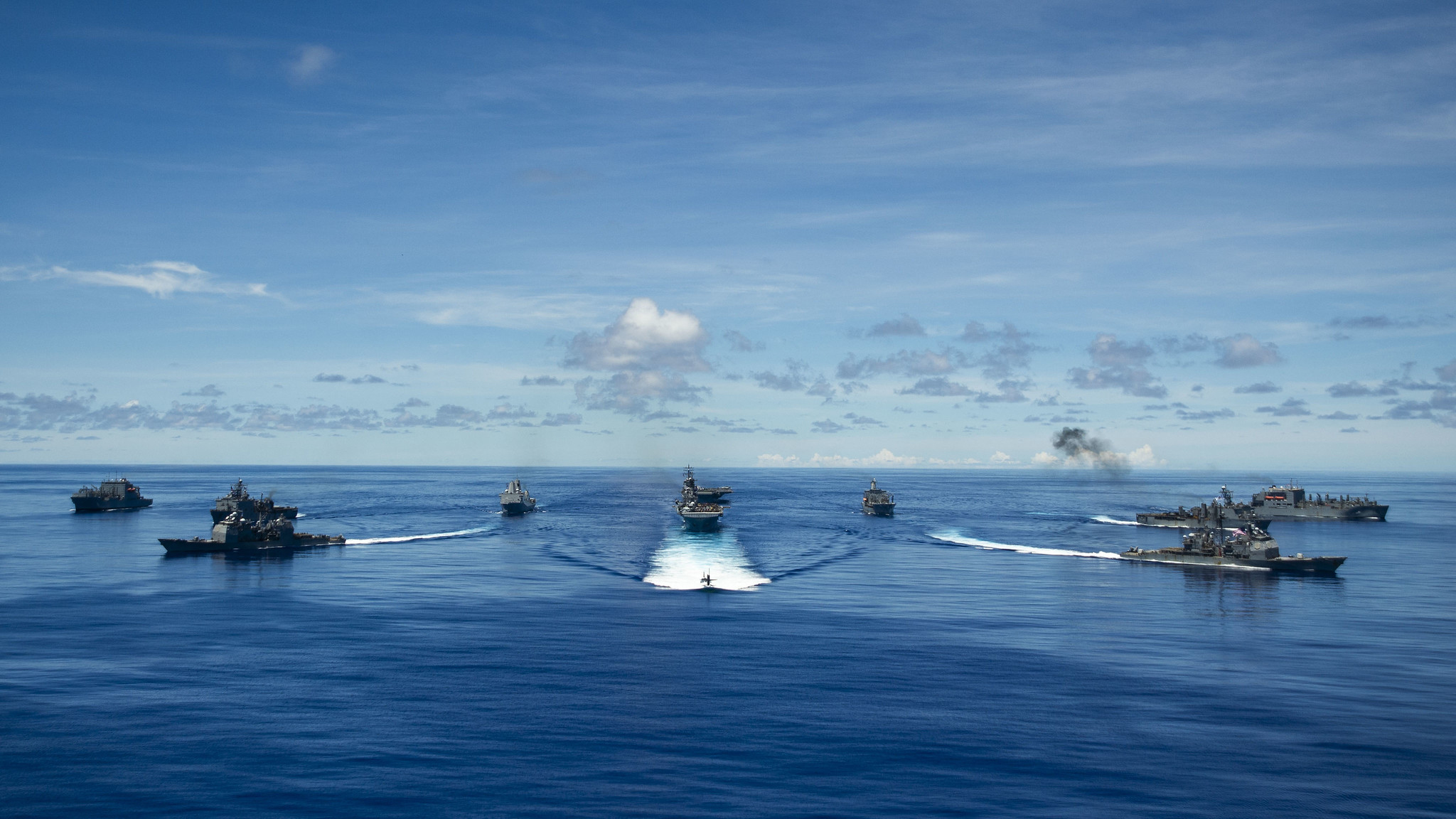The exercise also served as the Air Force's third "On Ramp" demo for its Advanced Battle Management System (ABMS), demonstrating a new software for battlefield situational awareness.
By THERESA HITCHENSon October 07, 2020 at 7:01 AM
Valiant Shield 2020 involved the sinking of a Navy frigate by Joint Forces
WASHINGTON: Key portions of the new American way of war, All Domain Warfare, were tested for the first time during the recent Valiant Shield exercise in the Pacific.
The exercise also served as the Air Force’s third “On Ramp” demo for its Advanced Battle Management System (ABMS) and afforded “the first opportunity to integrate and experiment with the technology in an overseas Combatant Command operational exercise,” a spokesperson for Pacific Air Forces told Breaking D yesterday. “Additionally, VS20 is the first in a series of exercises that will quickly translate new concepts, such as ABMS, key to the war-winning effectiveness of the Joint Force.”
Besides incorporating ABMS, Valiant Shield 2020 also gave let the Army begin to validate its Multi Domain Task Force concept.
“The ability to rapidly surge combat-ready forces using Army watercraft across the theater is critical to projecting forces at a moment’s notice to support regional alliances and reinforce the existing security architecture,” Army Col. Theodore White said in a Sept. 28 press release from Indo-Pacific Command (INDOPACOM). “Participating in joint exercises like Valiant Shield allow Army watercraft to integrate with the joint force to meet the Theater Joint Force Land Component Commander’s intent.”
The Marine 5th Air Naval Gunfire Liaison Company also provided” real-time guidance support for a live-fire sea-based TLAM strike on a ground target,” the release says.
Valiant Shield 20 was a substantial exercise, involving more than 11,000 soldiers, marines, sailors, and airmen. The main scenario involved the sinking of the decommissioned Navy frigate USS Curts (FFG 38), otherwise known as a SINKEX, on Sept. 19.
“The SINKEX included air-launching ordnance from fixed and rotary wing squadrons of Carrier Air Wing (CVW) 5, embarked aboard USS Ronald Reagan (CVN 76), surface launched missiles from cruisers USS Antietam (CG 54) and Shiloh (CG 67), as well as various supporting Navy and U.S. Air Force aircraft,” the INDOPACOM release said.
While Valiant Shield is typically run out of Guam, COVID-19 restrictions this year meant that while most of the operations were in the nearby waters, some elements had to be scaled back and moved to Joint Base Pearl Harbor-Hickam, Hawaii. Likewise, ABMS On Ramp 3 had to be redesigned, the PACAF spokesperson said.
For example, the ABMS demo was not able to include the Kratos XQ-58 Valkyrie drone to link directly to 5th generation fighters and “execute connectivity at the ‘edge’ through manned and unmanned teaming” as originally planned, the PACAF spokesperson said.
“The original design of ABMS OnRamp #3 was to incorporate and equip the [Multi-Domain Operations Center, MDOC] with new capabilities to receive relevant data from forward sensors, Low-Earth Orbit (LEO) assets, and other experimental software to accelerate decision-making processes in contested environments at the tactical edge. When COVID travel restrictions emerged, only software was provided to the MDOC design. This software was leveraged alongside legacy systems,” the PACAF spokesperson said.
The MDOC, the spokesperson explained, “is a small, joint team in a forward location designed to synchronize Joint functions (e.g. ISR, fires, sustainment, movement/maneuver)” including in a contested or denied environment.
Among the Air Force assets involved were C-130Js, EC-130, E-3s, F-16s, F-22s, KC-10s, and KC-135s.
As Breaking D readers know, Air Force acquisition czar Will Roper had hopes that the third ABMS demo would demonstrate the Valkyrie’s ability to connect to a piloted aircraft and perform traditional “wingman” functions. He also was hoping that the Valkyrie could again carry the ABMS gatewayONE to allow F-35s and F-22s to communicate machine-to-machine.
The ABMS demo was able to show off the new C2IMERA software (pronounced ‘chimera,’ and developed by Leidos) to demonstrate how data from myriad sensors can be integrated to provide battlefield situational awareness to commanders at both the mock ‘headquarters’ bases and and the small Forward Operating Bases (FOB)s. Its success proved out “a new capability to command and control Agile Combat Employment (ACE)” and support the evolving strategy for “Logistics Under Attack.”
ACE is the Air Force effort to disperse operations from a few large bases to include staging posts such as civilian airfields or remote locations with few amenities.
Figuring out how to ensure the availability of supplies in a high-end fight with Russia and China is not only a high priority for the Air Force as it retools for Joint All Domain Operations, it also is a key piece of the military’s evolving Joint Warfighting Concept — with the Army tapped by as the lead service for fleshing out how traditional approaches to logistics trains can be re-thought.

First Joint Exercise To Test All-Domain Capabilities: Valiant Shield 2020 - Breaking Defense
The exercise also served as the Air Force's third "On Ramp" demo for its Advanced Battle Management System (ABMS), demonstrating a new software for battlefield situational awareness.

